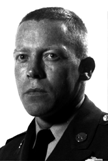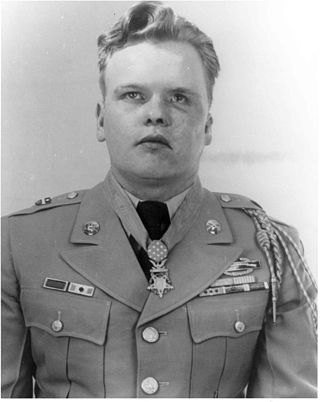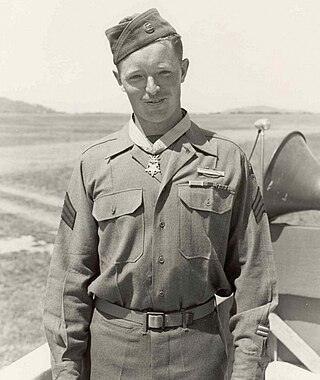Medal of Honor citation
Sjogren, John C.
Rank and organization:Staff Sergeant,Company I, 160th Infantry Regiment, 40th Infantry Division
Place and date:Near San Jose Hacienda, Negros, Philippine Islands, May 23, 1945
Entered service at:Rockford, Michigan
Citation:
He led an attack against a high precipitous ridge defended by a company of enemy riflemen, who were entrenched in spider holes and supported by well-sealed pillboxes housing automatic weapons with interlocking bands of fire. The terrain was such that only 1 squad could advance at one time; and from a knoll atop a ridge a pillbox covered the only approach with automatic fire. Against this enemy stronghold, S/Sgt. Sjogren led the first squad to open the assault. Deploying his men, he moved forward and was hurling grenades when he saw that his next in command, at the opposite flank, was gravely wounded. Without hesitation he crossed 20 yards of exposed terrain in the face of enemy fire and exploding dynamite charges, moved the man to cover and administered first aid. He then worked his way forward and, advancing directly into the enemy fire, killed 8 Japanese in spider holes guarding the approach to the pillbox. Crawling to within a few feet of the pillbox while his men concentrated their bullets on the fire port, he began dropping grenades through the narrow firing slit. The enemy immediately threw 2 or 3 of these unexploded grenades out, and fragments from one wounded him in the hand and back. However, by hurling grenades through the embrasure faster than the enemy could return them, he succeeded in destroying the occupants. Despite his wounds, he directed his squad to follow him in a systematic attack on the remaining positions, which he eliminated in like manner, taking tremendous risks, overcoming bitter resistance, and never hesitating in his relentless advance. To silence one of the pillboxes, he wrenched a light machinegun out through the embrasure as it was firing before blowing up the occupants with handgrenades. During this action, S/Sgt. Sjogren, by his heroic bravery, aggressiveness, and skill as a soldier, single-handedly killed 43 enemy soldiers and destroyed 9 pillboxes, thereby paving the way for his company's successful advance. For his heroic act in the war the city of Rockford, Michigan had a day for him. They called it Sjogren day on the date of September 14. After serving the two wars he came home to live in peace. John lost his life to cancer.
See also
Married to Jean both great friends of Col. William F and Metta Courtright and William P. Courtright who they embraced as the son they never had.
As their adopted son and behalf of my father and mother who have also passed, John and Jean are deeply missed "William (Bill) Courtright 2019).
John never spoke of his service as few Medal recipients ever do he did what was expected and was very humble in his acknowledgement of it seeing those who fought and died beside him more deserving.
John is remembered as a great man and my memories of him will be passed through my family for generations to come.
John stood the best that America is, has, and will be.

Rodger Wilton Young was a United States Army infantryman from Ohio during World War II. Born in the small town of Tiffin, Ohio, in 1932, Young suffered a sports injury in high school that led to his becoming nearly deaf and blind. Despite this, he was able to pass the exams necessary to enter the Ohio National Guard. Soon after the United States entered World War II, Young's company was activated as part of the U.S. Army. Soon after his activation, in 1943, Young was killed on the island of New Georgia in Solomon Islands while helping his platoon withdraw from a Japanese ambush. For his actions, he was posthumously awarded the United States' highest military decoration, the Medal of Honor.

Sergeant Darrell Samuel Cole was a United States Marine who posthumously received the United States' highest military decoration, the Medal of Honor, for his conspicuous gallantry at the Battle of Iwo Jima during World War II.

Joe Ronnie Hooper was an American who served in both the United States Navy and United States Army where he finished his career there as a captain. He earned the Medal of Honor while serving as an army staff sergeant on February 21, 1968, during the Vietnam War. He was one of the most decorated U.S. soldiers of the war and was wounded in action eight times.

Sergeant Alejandro Renteria Ruiz was a United States Army soldier who received the Medal of Honor, the United States' highest military decoration, for his actions in the Battle of Okinawa in the Ryukyu Islands during World War II.

Nelson Vogel Brittin was an American combat soldier who was killed in action during the Korean War. He was posthumously awarded the Medal of Honor for his actions in Yonggong-ni, Korea, on March 7, 1951.

Einar Harold Ingman Jr. was a United States Army soldier who received the Medal of Honor for his actions during the Third Battle of Wonju in the Korean War.

Maximo Yabes born in Lodi, California, was a United States Army soldier who posthumously received the Medal of Honor — the United States' highest military decoration — for his actions near Phu Hoa Dong in South Vietnam during the Vietnam War. Yabes distinguished himself when he used his body as a shield to protect others in a bunker, moved two wounded men to a safer position where they could be given medical treatment and destroyed an enemy machine gun position before being mortally wounded.

Kenneth Edward Stumpf was a United States Army soldier and a recipient of the United States military's highest decoration, the Medal of Honor, for his actions in the Vietnam War.

Finnis Dawson McCleery was a United States Army soldier and a recipient of the United States military's highest decoration—the Medal of Honor—for his actions in the Vietnam War.

Ted Belcher was a United States Army soldier and a recipient of the United States military's highest decoration—the Medal of Honor—for his actions in the Vietnam War. He was also a recipient of a Purple Heart, a National Defense Medal, and both the Vietnam Service and Vietnam Campaign Medals.

Max Thompson was a United States Army soldier and a recipient of the United States military's highest decoration—the Medal of Honor—for his actions in World War II.
Seymour W. Terry was a United States Army officer and a recipient of the United States military's highest decoration—the Medal of Honor—for his actions in World War II.
Leo J. Powers was a United States Army soldier and a recipient of the United States military's highest decoration—the Medal of Honor—for his actions in World War II during the Battle of Monte Cassino.

Robert Earl Laws was a United States Army soldier and a recipient of the United States military's highest decoration—the Medal of Honor—for his actions in World War II.

Oscar Godfrey Johnson Jr. was a United States Army soldier and a recipient of the United States military's highest decoration—the Medal of Honor—for his actions in World War II.
Roy Woodroe Harmon was a United States Army soldier and a recipient of the United States military's highest decoration—the Medal of Honor—for his actions in World War II.
George John Hall was a United States Army soldier and a recipient of the United States military's highest decoration—the Medal of Honor—for his actions in World War II.
Kenneth E. Gruennert was a United States Army soldier and a recipient of the United States military's highest decoration—the Medal of Honor—for his actions in World War II.
Jesse Ray Drowley was a United States Army soldier and a recipient of the United States military's highest decoration—the Medal of Honor—for his actions in World War II.
Alvin P. Carey was a soldier in the United States Army who received the Medal of Honor for actions during World War II in France. He joined the Army from Laughlinstown, Pennsylvania, in January 1941.
This page is based on this
Wikipedia article Text is available under the
CC BY-SA 4.0 license; additional terms may apply.
Images, videos and audio are available under their respective licenses.











